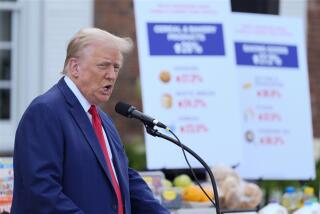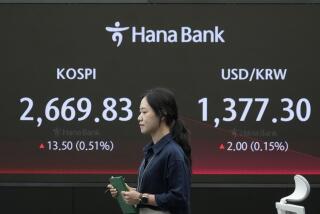Federal Reserve chairman to meet regularly with media
- Share via
Reporting from Washington and Los Angeles — Long one of the most secretive and inscrutable government institutions, the Federal Reserve for the first time will allow its chairman to meet regularly with reporters to explain the central bank’s actions.
The decision to have Chairman Ben S. Bernanke hold quarterly news briefings comes as the Fed tries to become more open in the face of intense criticism of the unprecedented steps it took during the financial crisis to help large banks and Wall Street firms.
“It was pretty clear that the Fed needed to do something to be seen as more open,” said Vincent Reinhart, a former Fed official and resident scholar at the American Enterprise Institute for Public Policy Research.
Former Fed Chairman Alan Greenspan was renowned for his public obfuscation, earning the nickname “the Oracle” after the ambiguous pronouncements delivered at Greek shrines.
“I’ve learned to mumble with great incoherence,” he once boasted to a congressional committee.
Before 1994, the Fed didn’t even release a statement after meetings of its Open Market Committee, which sets monetary policy, including the benchmark U.S. short-term interest rate.
Now, the Fed will make Bernanke available to answer questions following four of those meetings each year and broadcast the briefing live on the central bank’s website. The first will be April 27.
“The introduction of regular press briefings is intended to further enhance the clarity and timeliness of the Federal Reserve’s monetary policy communication,” the central bank said. “The Federal Reserve will continue to review its communications practices in the interest of ensuring accountability and increasing public understanding.”
The Fed is following what already is standard practice for the heads of other major central banks, including the European Central Bank and the Bank of Japan. They have long met with reporters in on-the-record sessions after policy meetings.
By contrast, the Fed in recent years has simply issued a statement, without further explanation, after its meetings — leaving economists, journalists and the public to decipher the wording and the implications for policy and the economy. They have to wait three weeks for more details when the minutes of those meetings are released.
But the symbolism of the quarterly news conferences might be more valuable than anything said during them, Reinhart said. Bernanke’s comments are likely to be highly scripted, similar to those of European Central Bank President Jean-Claude Trichet.
“Trichet really manages the process and tries really hard not to be dramatic,” Reinhart said. “It’s one of those events, from the Fed’s perspective, that only has downside risk. You only make news … if you make a mistake.”
Despite those risks, the Fed has made the move to counter backlash from the extensive steps it took starting in 2008 to try to stabilize the financial system. Those included the controversial rescue of insurance giant American International Group Inc. and the hundreds of billions of dollars it pumped into the economy to stimulate demand.
Lawmakers have pressed for more information about the recipients of the Fed’s loans, enacting new disclosure requirements as part of last year’s overhaul of financial regulations.
Last year, Bloomberg News sued in federal court to get details about Fed loans released. On Monday, the Supreme Court rejected an appeal by major banks to keep the details secret.
In the face of mounting pressure to be more accountable to the public, Bernanke has tried to open up.
In an unprecedented move, he appeared on CBS’ “60 Minutes” in March 2009 to discuss the Fed’s financial bailout moves. A few months later, Bernanke held a town hall meeting in Kansas City, Mo., to take questions from a live audience.
“I’m answerable to the American people,” he told the crowd.
The Fed revealed in the minutes of its November meeting that it was considering having the chairman “hold occasional press briefings to provide more detailed information to the public regarding the committee’s assessment of the outlook and its policy decision making.”
In another unusual step, Bernanke gave a speech last month at the National Press Club in Washington, and then answered written questions from journalists. He joked about the convoluted wording of Fed policy statements as he responded to questions that included the crisis at the time in Egypt and his pick for the Super Bowl.
Asked about the possibility of regular press briefings, he said there were pluses and minuses.
“On the one hand, real-time transparency is very important and valuable,” he said. “On the other hand, we don’t want to create unnecessary uncertainty, unnecessary volatility in financial markets by saying things that may be misinterpreted … if they’re too ad hoc.”
Reinhart said that was unlikely.
He said there would be more value in the Fed releasing its briefing books after each meeting, showing the economic forecasts and models it used to come to its policy decisions.
In the end, the news conference might just add to the influence of the central bank chairman, who will get to give his version of the behind-the-scenes meeting a week before the other Fed governors are allowed to discuss them, Reinhart said.
“He’s probably going to be risk-averse when he does these, therefore its going to be as scripted and as undramatic as possible,” Reinhart said.
More to Read
Inside the business of entertainment
The Wide Shot brings you news, analysis and insights on everything from streaming wars to production — and what it all means for the future.
You may occasionally receive promotional content from the Los Angeles Times.











